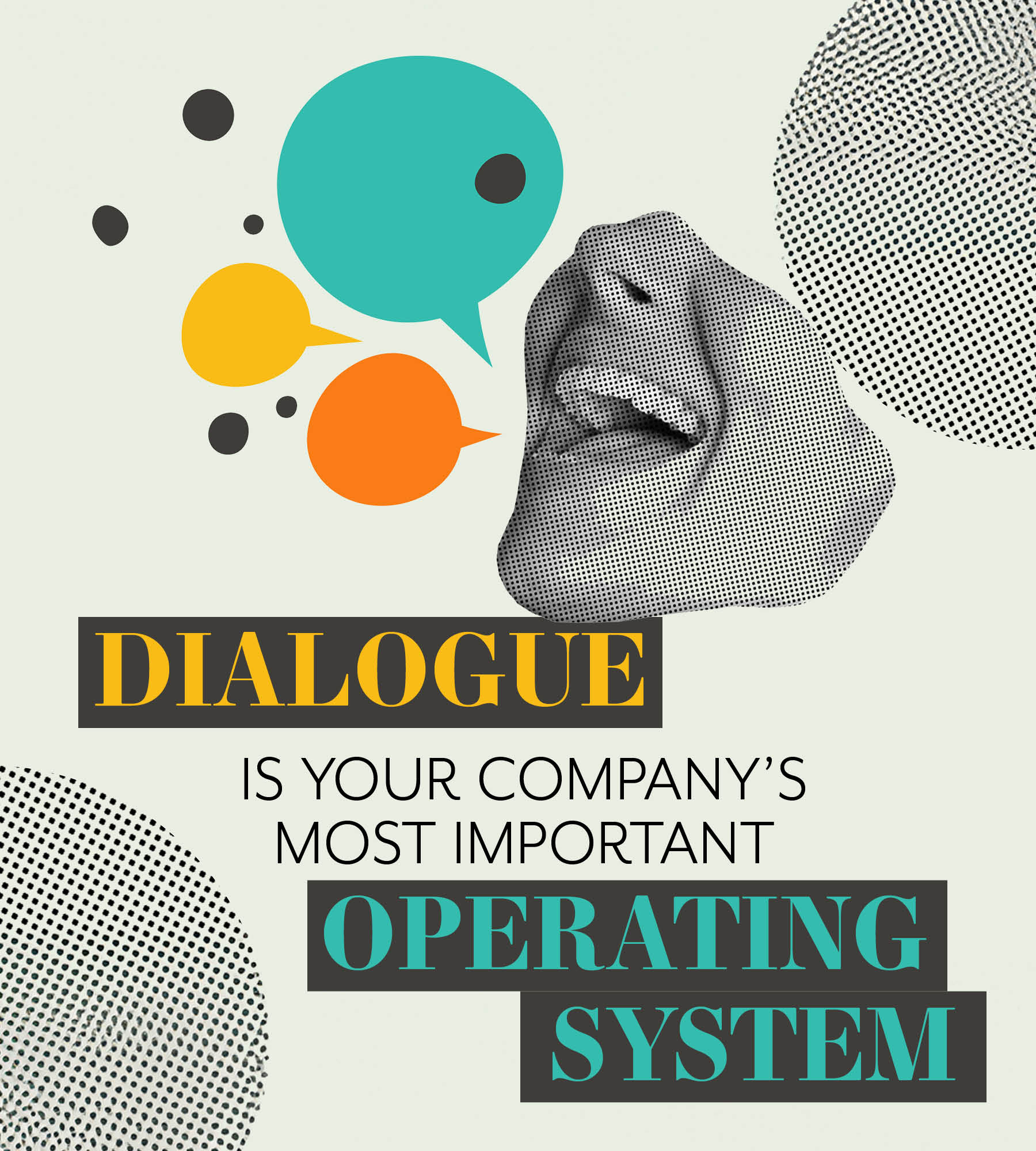Language
You can read the magazine in one of the following languages
Let me ask you a philosophical question: What is your company made of? Is it made of money? Well, of course it took money to create the company, but if that’s all it took, then all companies would look identical.
Is it made of people? Yes – but without them interacting and having conversations, all those people would just be standing around, not knowing what to do.
Is it made of ideas? Most certainly – but how many people had great ideas that never led to anything? And did those ideas organize themselves into the products and services you have today?

The thing that best captures what your company is built on is one word: conversations.
No, the thing that best captures what your company is built on is one word: conversations. If you are a founder, it started with the conversations you had with your co-founders, prospective customers, early investors and new hires.
If you’re a leader in a larger company, it’s the conversations you and hundreds of colleagues before you had that resulted in today’s product offerings, customers and capabilities. Indeed, if you had a magic microscope that could peer into the origins of everything your company does – every product, every marketing strategy and every line of code in your business – you’d see that they were all the result of the conversations that preceded them.
The quality of the conversations we have largely determines the quality of the products, strategies, business processes and hiring decisions that result from them. But not all conversations are equally good or produce equally good results. The best conversations are those where people think together to harness the collective intelligence, knowledge, insights and experience of the people involved. And that is what I call dialogue.
Ordinary conversations are great for all kinds of things – deciding where to have lunch, organizing an event, or updating people on the status of your project. But when there’s an important matter at hand, and people hold strong views about it, then ordinary conversations don’t have a great track record.

There are two fundamentally different types of conversations ‘it’ and ‘us’, and each carries its own intrinsic challenge.
‘It’ conversations are all about your business: strategy, targets, customers, projects, products and money. ‘Us’ conversations are about, well, us: how we are getting along or working together, who is better suited to taking on a particular role, what went wrong in the team meeting that caused someone to walk out upset.
People are generally comfortable dealing with an ‘it’ issue until there’s some meaningful disagreement. How often have you gone into a discussion thinking, “This one’s a no-brainer; the answer is clear as day”, only to find that, lo and behold, other people see it quite differently? Maybe they don’t agree on the problem. Or they agree on the problem but not on the solution. Or perhaps they even agree on the solution but for completely different reasons. The reality is that everyone has their own unique perspective on almost everything.
If by some strange chance you went to a meeting where everyone saw the issues the same way, the meeting would be fun: you could all congratulate and high-five each other on how smart you are but it would also be a complete waste of time.

There are two fundamentally different types of conversations ‘it’ and ‘us’, and each carries its own intrinsic challenge.
This points to a simple but profound truth: the purpose of any meeting that can add real value is to explore different perspectives in order to generate ideas, solutions and decisions that are better than any one person could have come up with on their own. After all, if we’re not coming up with something over the course of a meeting that is better than we started with. Why have it at all?
This is the essence of collective thinking. The problem is that it happens all too rarely.
Take a moment to consider the interactions in your company. Do you see people exhibiting any of these behaviors?
In most organizations, these things happen all the time. In fact, many of us are so accustomed to these behaviors that we have stopped noticing how harmful and destructive they are. Instead, we just push through until the issue at hand is resolved one way or the other, and then we move on rather than trying to improve the underlying interaction that went wrong in the first place.

The right/wrong, win/lose mentality still tends to prevail and it prevents collective thinking.
These behaviors are all reflections of a frame of mind in which one idea (mine!) is (entirely) right and other ideas (all of yours!) are therefore (entirely) wrong. In this world, there are only winners and losers. Even in situations where you may not see these unhelpful behaviors, the right/wrong, win/lose mentality still tends to prevail and it prevents collective thinking.
A simple but powerful reframe will help you navigate differences in perspective and generate collective thinking much more successfully.
If we can replace our right/wrong frame with the starting assumption that we’re probably both partly right, then this naturally leads to very different behaviors.
This assumption is the essence of intellectual humility. If we’re both super confident in our point of view, then we will inevitably approach any disagreement with a win/lose frame of mind. But if we’re both aware that our insights and knowledge have limits, that we can never have all the relevant information, that others may have information or insights that we lack, and that even we can make mistakes, then we will naturally approach these types of conversations very differently. In this world, we naturally assume we have something to learn from each other, and that changes everything.
Once we have each learned from the other, shared the information I had that you didn’t, explained the option you could see that I couldn’t, explored the constraints that you were aware of that I was not, then we are heading in the right direction.
Collective thinking enables us to explore what’s most compelling and relevant in different people’s thinking, as well as what is not so robust, so that we can build something better than what we started with.

Collective thinking enables us to explore what’s most compelling and relevant in different people’s thinking.
When there are only two people in a discussion, it’s not so hard to achieve this synergy, but it becomes dramatically harder as the number of people in the room grows.
In larger meetings, a small minority typically dominate the airtime, leaving others struggling to get a word in edgewise or, more often, not even bothering to try. By the time you have 10 people or more, it’s really challenging to harness the collective intelligence of the room and not spend all day doing it. And this is, of course, all much more difficult when meetings are virtual.
So that’s why we need to master the art of collective thinking, both for groups of two and for larger groups. Because when people are truly thinking and learning together, then new, better solutions emerge that harness the diversity in your organization by drawing on the knowledge and insights of everyone involved. People experience these conversations as powerful, energizing, and as time incredibly well spent. They are the embodiment of productivity.
And when each person involved in that conversation feels that their voice was heard and that they had at least some in influence on the outcome, then they will feel far more committed to taking the plan forward, as well as to giving their very best to this group the next time it works together. That is the embodiment of positivity. It’s also a very good working definition of inclusivity.

Rob Bier
Contributor Collective Member
Rob Bier is a seasoned expert in building high-performance organizations, with over 20 years’ experience in the field. He has helped companies to scale successfully, including eight that became unicorns or decacorns while he worked with them. Rob is the driving force behind Trellis Partners, a firm that supports entrepreneurs and business leaders with leadership, teaming, strategy, scaling and execution. He is the author of ‘Smooth Scaling: 20 Rituals to Build a Friction-Free Organization’. He is also the Co-Founder and Chairman of MoneySmart, South-East Asia’s leading online financial comparison site. For more information visit https://www.robbier.com/smooth-scaling
